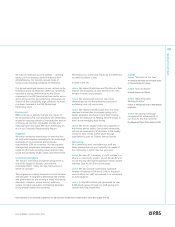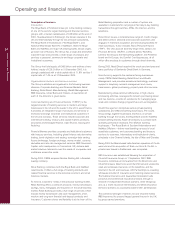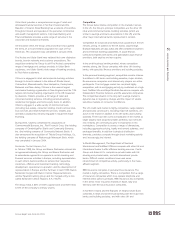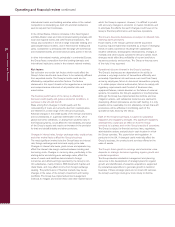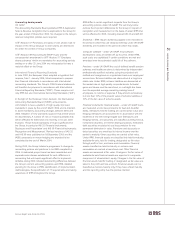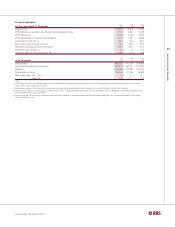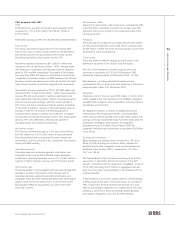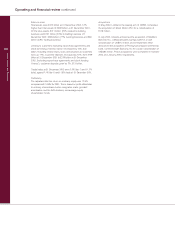RBS 2003 Annual Report Download - page 59
Download and view the complete annual report
Please find page 59 of the 2003 RBS annual report below. You can navigate through the pages in the report by either clicking on the pages listed below, or by using the keyword search tool below to find specific information within the annual report.
57
Operating and financial review
Annual Report and Accounts 2003
Critical accounting policies
The reported results of the Group are sensitive to the accounting
policies, assumptions and estimates that underlie the preparation
of its financial statements. The Group’s principal accounting
policies are set out on pages 137 to 140. UK company law and
accounting standards require the directors, in preparing the
Group’s financial statements, to select suitable accounting
policies, apply them consistently and make judgements and
estimates that are reasonable and prudent. Where UK GAAP
allows a choice of policy, Financial Reporting Standard (“FRS”)
18 ‘Accounting Policies’ requires an entity to adopt those
policies judged to be most appropriate to its particular
circumstances for the purpose of giving a true and fair view.
The judgements and assumptions involved in the Group’s
accounting policies that are most important to the portrayal of
its financial condition are discussed below. The use of
estimates, assumptions or models that differ from those
adopted by the Group would affect its reported results.
Provisions for bad and doubtful debts
The Group provides for losses existing in its lending book so
as to state its impaired loan portfolio at its expected ultimate
net realisable value. Specific provisions are established against
individual exposures and the general provision covers
advances impaired at the balance sheet date but which have
not been identified as such. Bad and doubtful debt provisions
made during the year less amounts released and recoveries of
amounts written-off in previous years are charged to the profit
and loss account. Loans and advances are reported on the
balance sheet net of specific and general provisions.
For certain homogeneous portfolios, including credit card
receivables and other personal advances including mortgages,
specific provisions are established on a portfolio basis, taking
into account the level of arrears, security, past loss experience,
credit scores and defaults based on portfolio trends. The most
significant factors in establishing these provisions are the
expected loss rates and the related average life. These factors
are kept under constant review by the Group.
For loans and advances that are individually assessed, the
specific provision is determined from a review of the financial
condition of the borrower and any guarantor and takes into
account the customer’s debt capacity and financial flexibility;
the level and quality of earnings; the amount and sources of
cash flows; the industry in which the customer operates; and
the realisable value of any security held. The most significant
estimates that affect the quantum of a specific provision are
the amounts and timing of receipts from the borrower and the
amount that will be recovered from any security held.
Evaluating these estimates involves significant judgement as
receipts will depend on the future performance of the borrower
and the value of security, both of which will be affected by
future economic conditions. Additionally, the security may not
be readily marketable.
The general provision covers bad and doubtful debts that have
not been separately identified at the balance sheet date but
are known to be present in any portfolio of advances. The level
of general provision is assessed in the light of past experience
and reflects the size and diversity of the Group’s loan portfolio,
the current state of the economies in which the Group operates,
other factors affecting the business environment, recent trends
in companies going into administration, receivership and
bankruptcy and the Group’s monitoring and control procedures,
including the scope of specific provisioning procedures.
The future credit quality of the Group’s lending book is subject
to uncertainties that could cause actual credit losses to differ
materially from reported loan loss provisions. These
uncertainties include the economic environment, notably
interest rates and their effect on customer spending, the
unemployment level, payment behaviour and bankruptcy trends
and changes in the Group’s portfolios.
Loans and advances – recognition of interest income
Where the collectibility of interest is in doubt it is excluded
from the profit and loss account but is credited to an interest in
suspense account. As interest charged to overdraft accounts
loses its identity, the determination of the collectibility is
generally achieved through individual file reviews. However, for
some products, such as personal loans and credit cards,
suspension of interest is automated based on the number of
payments in arrears. Such automated suspension of interest
may be accelerated in the event of death, bankruptcy, legal
proceedings or financial hardship. Notwithstanding any
arrears, where it is established that the customer is able to
cover interest, it is credited to the profit and loss account.
Loans classified as impaired and any related suspended
interest are written-down to their estimated net realisable value
when it is determined that there is no realistic prospect of
recovery of all or part of the loan.




